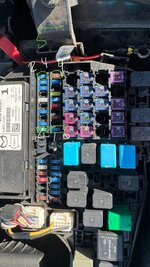I am racking my brain trying to figure out my battery drain.
Info:
2016.5 CX5 Grand Touring
Brand new battery
Original alternator
No aftermarket modifications.
I went away for a week. I came back to a dead battery. I figured ok yea this is normal. So I jumped it and let it charge. I said ok that’s it. Then over night it discharged to probably around 12.3 v bc it struggled to turn over. I thought that’s weird it was never like this before. So charge the battery by driving. The battery never really got over 12.3 volts when turned off. I tested the alternator and I get 13.8 volts when vehicle is running. I changed the battery 3 days ago under warranty because it wasnt holding charge. The new battery after a nice drive was at 12.8 volts when I turned the vehicle off. Over night it dropped to around 12.5-12.6. So I figure this is the resting voltage. Fast forward to today and it was dead this morning. So I took out the multimeter and tested the negative in series and was getting around 1.6-1.7 amps drawn. Then I tested the voltage drop of the fuses after the computer was completely shut down, and saw 4 of the low profile fuses drawing about 4.6 millivolts all together. I pulled the four fuses and when in series the draw went down to around .4 amps. Which seems like a normal draw. The car is undriveable without those fuses. I attached a picture showing which fuses. I have yet to test the cases fuses or relays bc I’m waiting for a tool to come in instead of using pliers or the included tiny tool. In the picture the white number is the millivolts dropage. Any help will be appreciated. I will test the internal fuse box when I get home.
Info:
2016.5 CX5 Grand Touring
Brand new battery
Original alternator
No aftermarket modifications.
I went away for a week. I came back to a dead battery. I figured ok yea this is normal. So I jumped it and let it charge. I said ok that’s it. Then over night it discharged to probably around 12.3 v bc it struggled to turn over. I thought that’s weird it was never like this before. So charge the battery by driving. The battery never really got over 12.3 volts when turned off. I tested the alternator and I get 13.8 volts when vehicle is running. I changed the battery 3 days ago under warranty because it wasnt holding charge. The new battery after a nice drive was at 12.8 volts when I turned the vehicle off. Over night it dropped to around 12.5-12.6. So I figure this is the resting voltage. Fast forward to today and it was dead this morning. So I took out the multimeter and tested the negative in series and was getting around 1.6-1.7 amps drawn. Then I tested the voltage drop of the fuses after the computer was completely shut down, and saw 4 of the low profile fuses drawing about 4.6 millivolts all together. I pulled the four fuses and when in series the draw went down to around .4 amps. Which seems like a normal draw. The car is undriveable without those fuses. I attached a picture showing which fuses. I have yet to test the cases fuses or relays bc I’m waiting for a tool to come in instead of using pliers or the included tiny tool. In the picture the white number is the millivolts dropage. Any help will be appreciated. I will test the internal fuse box when I get home.

